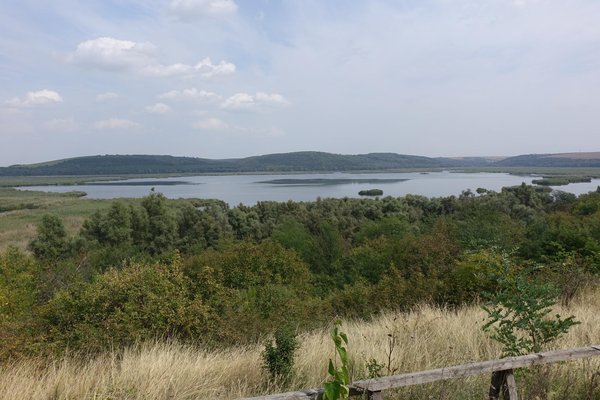Bulgaria
Srebarna Nature Reserve
Srebarna Nature Reserve is a lake and wetland habitat on the bird migration route between Europe and Africa.
It comprises Lake Srebarna and its surroundings, which are located on the west bank of the Danube River. It is home to some 180 bird species, both breeding and migrating. Among the most interesting waterfowl are the Dalmatian Pelican, Pygmy Cormorant, Great White Egret, Glossy Ibis and Spoonbill.
Community Perspective: It is very similar in scenery and bird list to the Danube Delta, less than 200km away. Near the lake lies a small visitor center / museum, and from the surrounding hills you can observe the birdlife. Tsunami managed to visit on public transport, while Nan and Els entered during the 2018 WH Community Meeting, where they were educated by birder Peter and shocked by the upkeep. Clyde has provided some birding tips.
Site Info
Official Information
- Full Name
- Srebarna Nature Reserve (ID: 219)
- Country
- Bulgaria
- Status
-
Inscribed 1983
Site history
History of Srebarna Nature Reserve
- 2003: Removed from Danger list
- 1992: In Danger
- "series of upstream interferences, including the Iron Gates Dam, have permanently altered the natural hydrology of the Danube River in the region and that of Srebarna, located downstream along the river"
- 1983: Inscribed
- Inscribed
- Type
- Natural
- Criteria
- x
Links
- UNESCO
- whc.unesco.org
- Official
-
- bulgariatravel.org — Bulgaria Travel
- Related
-
- en.wikipedia.org — Link
All Links
UNESCO.org
- whc.unesco.org — whc.unesco.org/
Official Website
- bulgariatravel.org — Bulgaria Travel
Related Resources
- en.wikipedia.org — Link
News Article
- May 9, 2014 standartnews.com — British family create visitor center for Srebarna
Community Information
- Community Category
- Natural landscape: Rivers, Wetlands and Lakes
Travel Information
Recent Connections
-
Perfect Inscriptions
1983 -
Pelicans
"Among the most interesting bird specie… -
Eagles
White-tailed Eagle (Official descriptio…
Connections of Srebarna Nature Reserve
- Geography
- Trivia
-
-
Smallest natural WHS
638 ha (10)
-
- Ecology
-
-
Pelicans
"Among the most interesting bird species are the Dalmatian pelican, great egret, night heron, purple heron, glossy ibis and white spoonbill." (Official description) -
Eagles
White-tailed Eagle (Official description) -
Bird Migrations
Bird migration route -
Otters
-
Oxbow lakes
Srebarna Lake (an oxbow of the Danube) -
Strict Nature Reserve
Fully. "There is a hide for viewing the pelicans, but tourism, hunting and commercial activities in the Reserve are strictly prohibited." (UNEP-WCMC)
-
- Damaged
-
-
Poaching
Birds and fish
-
- World Heritage Process
-
-
Perfect Inscriptions
1983 -
Former In Danger List sites
1992-2003
-
Inscribed on a single criterion only
x. to contain the most important and significant natural habitats for in-situ conservation of biological diversity, including those containing threatened species of outstanding universal value from the point of view of science or conservation.
-
- Religion and Belief
-
-
Legends and Folk Myths
surrounding its nameSee en.wikipedia.org
-
- WHS on Other Lists
-
-
Ramsar Wetlands
Srebarna, 1975 -
World Biosphere Reserves
Srébarna (1977) -
Natura 2000
The property is also included in two Natura 2000 sites: the Srebarna Special Protection Area and Ludogorie-Srebarna Special Area of Conservation. (Unesco website)
-
- Timeline
-
-
Holocene
"At the beginning of the Holocene about 11000 BC right after the so called Flandrian Transgression the riverbed underwent significnat changes .......according to palinological research Lake Srebarna has been formed about 8000 years ago"
-
- WHS Hotspots
- WHS Names
-
-
Named after a Lake
Lake Srebarna
-
News
- standartnews.com 05/09/2014
- British family create visitor cent…
Recent Visitors
Visitors of Srebarna Nature Reserve
- alex
- Alexander Barabanov
- Alexander Lehmann
- A. Mehmet Haksever
- Argo
- Astraftis
- Atila Ege
- BaziFettehenne
- Bin
- Brendan Carroll
- Cezar Grozavu
- Cheryl
- Christoph
- Clyde
- CynthiaW
- Dagmara
- Dimitar Krastev
- Elis
- Els Slots
- Emili Xaus
- Erik Jelinek
- Eva Kisgyorgy
- Fan Yibo
- Feldhase
- George Gdanski
- GeorgeIng61
- GerhardM
- Hadrianus
- Harry Mitsidis
- Hubert
- Iain Jackson
- Janos
- Jarek Pokrzywnicki
- Jasam
- Joel on the Road
- John Smaranda
- Jonas Kremer
- jonathanfr
- Joyce van Soest
- Justin Rickey
- Knut
- Lisu Marian
- Luis Filipe Gaspar
- Maciej Gil
- Małgosia Łupicka
- Mathijs
- Mihai Dascalu
- Mikko
- Miloš Tašković
- nan
- Nihal Ege
- Patrik
- Paul Schofield
- petar
- Peter Lööv
- Petteri
- Philipp Peterer
- Piotr Wasil
- Rafał Kałczuga
- Randi Thomsen
- Roger Ourset
- Roman Bruehwiler
- Sabrina Liebehentschel
- Schnitzel
- Shandos Cleaver
- Slavi
- Solivagant
- Stanimir
- Stanislaw Warwas
- Svein Elias
- Szucs Tamas
- Tamara Ratz
- Taotao Chen
- Tarquinio_Superbo
- Thomas Buechler
- Thomas van der Walt
- Tsunami
- UncleSlavi
- WalGra
- Wojciech Fedoruk
- Wo_ko
- YaroMir
- Yevhen Ivanovych
- Zoë Sheng
Community Reviews
Show full reviews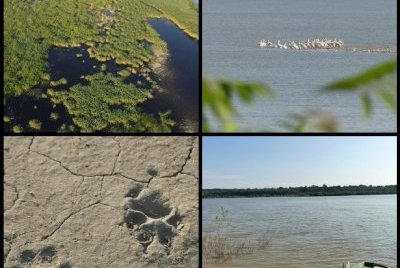
I visited this WHS in 2023. Knowing that this was one of the lowest ranking WHS in our community, I made sure to visit it first before the Danube Delta in Romania and I decided to spend two nights here to be able to explore more of the reserve at appropriate times of the day (i.e. sunrise and sunset) for more birdlife activity, as opposed to a touch-and-go experience.
Getting here by car in the summer months means visiting when the landscape is dominated by never-ending sunflower fields and the only hazard you'll meet on the road are the several huge harvesters. Srebarna is a very sleepy village, so much so that there is no grocer or an ATM! We stayed at a very low key B&B just next to the Natural Science/History Museum or Srebarna Nature Reserve Visitor Centre (free entrance on Thursdays) is too far to appreciate the best bird activity'; in fact it is best suited for a panoramic view (with binoculars and telescopes) of the nature reserve and to at least see any birds you missed out in the field ... but stuffed! There is a painted UNESCO and Man and Biosphere sign next to the museum entrance and a couple of new UNESCO WHS inscription boards along the ecotrail.
Years after the 2019 meetup I had missed, the overall upkeep of the ecotrail is now fully "eco", i.e. it has been engulfed by nature. Not only are all the remains of wooden handrails, …
Keep reading 0 comments
In advance, we had a lot of fun with the inclusion of Srebarna on the itinerary of our 2018 WH meetup. At that time it was the worst-rated WHS on our website. Would we be able to collectively raise the score after our visit? Srebarna is a freshwater lake that is an important breeding, transit and wintering place for waterfowl. The lake was originally connected to the nearby Danube - now the two are only connected via a channel. The protected area measures only 6 square kilometers. 75% of it is covered with reeds and other marsh plants.
During the preparations, I had tried to arrange a serious birding guide to show us around - but the few English-speaking ones I was able to track down were guiding elsewhere (even up to Sofia, perhaps a telling sign). Fortunately, we had with us Peter, a fellow world heritage traveller who is also a keen birder. He even prepared a presentation for us. Through this we became acquainted with the 4 most special birds of this area, that lies on the migratory route along the Black Sea: the Dalmatian pelican, the pygmy cormorant, the glossy ibis and the spoonbill.
From the visitor center we first walked down towards the lake. At least, 'in the direction of': around the lake, there is a dirt road that you can also drive by car. The trees and shrubs that separate the road from the shore have grown so high that the lake isn’t …
Keep reading 0 comments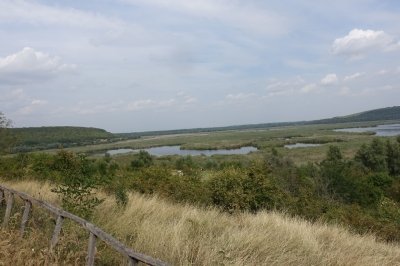
As part of our community meetup in Eastern Bulgaria, we decided to tackle the at the time worst rated site: Srebarna. Srebarna is meant to represent the ecosystem of a contributary lake to the Danube. The Bulgarians also argue that it's a good birding site. When we came, though, birds were in as short supply as were other visitors or tour guides for that matter.
Peter was so kind to prepare some material to provide context. But without birds present it didn't help much that day. Indeed, Peter was adamant that Srebarna is not a very unique birding site simply on account of the limited diversity of the bird populations.
My personal impression was fairly underwhelming and I can see the following reasons:
- Size: It's a fairly small national park.
- No wow factor: The site doesn't have anything outstanding, e.g. a unique species or a great scenery.
- Accessibility: There are very few trails and it's really hard to explore the site.
- Upkeep: The site is really in bad shape. Trails are overgrown and several installations have fallen into disrepair. See Els' pictures.
To me the accessbility point is the key short coming of the site. You can't even get down to the lake proper. I did expect some learning trails taking you into the different parts of the ecosystem with some explanation boards: "This is a world heritage site and this is our claim to fame!" But no. For birding some dedicated platforms …
Keep reading 0 comments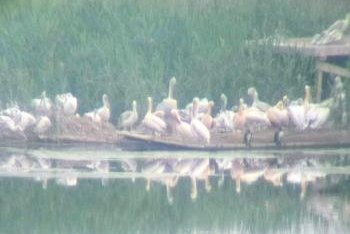
I got on a pontoon pushed by a ship from Calarasi, Romania, crossing the Danube / border to Silistra, Bulgaria.
Staying overnight in Silistra, I visited the Srebarna Nature Reserve WHS by bus. The sign at the bus stop for Bus 22 (located at 44°06'49.4"N 27°15'10.8"E) says it runs from 5:15 on but does not say exactly what time. So instead of milling around waiting for the bus at the bus stop, I decided to take another bus from the main bus station a few hundred meters away to the city of Ruse at 9:30 and get off at the entrance to the village of Srebarna.
As soon as I got off the bus at the entrance, an old lady who also got out of the bus just waved to the first car she saw to get a ride into the village, and I was at the visitor center/museum for the WHS in no time.
I first checked out the museum and then walked out to the lake. There were two groups of pelicans nesting in different shores of the lake.
This site is just one lake, so it wasn't as extraordinary and impressive as the Danube Delta.
Keep reading 0 comments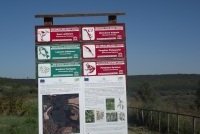
Bus no.22 from outside Silistra station dropped me at the Visitor Centre in Srebarna village.
After viewing the exhibits at the centre's museum I set of along several paths, one leading to the lake edge where fishing was in progress. Another path led northwards around the lake, affording views over the lake. At intervals were information boards with maps and details of the wildlife to be found in the vicinity.
Keep reading 0 comments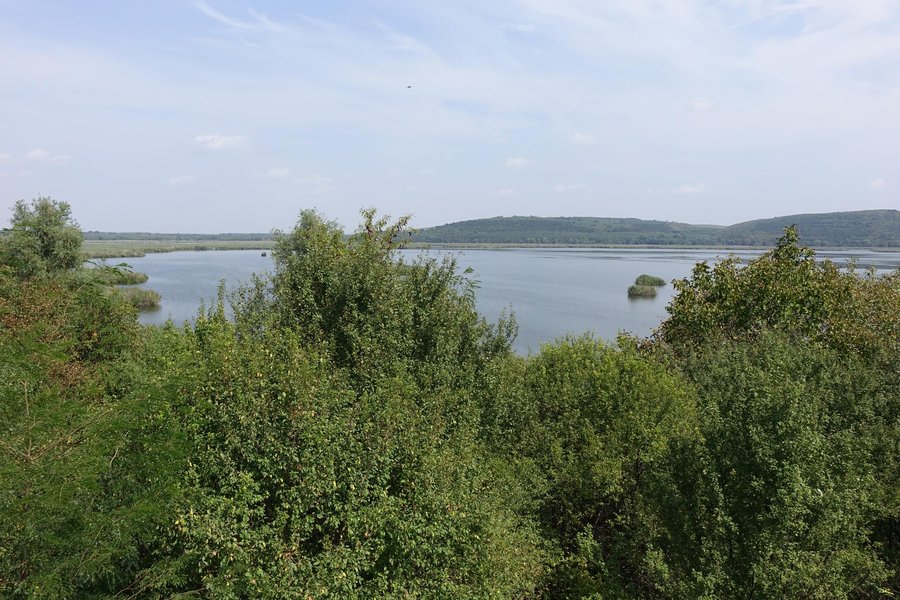
Yes ,there is no doubt about it that this place is worth a visit if nature is what you are about. The drive from Sofia which takes 5 hours gets nicer as you get closer to SREBARNA in fact the last 15km or so reminded me of parts of Wales (beautiful countryside. The place is looking tired but a new mayor has been appointed 6 months ago (Jan 2008) who is a local of the village and has set about 'tidying' the place up. A place to watch in the furture I think and that was why I bought property there overlooking the lovely lake !
Keep reading 0 comments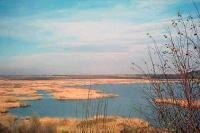
I can conceive of only 2 reasons why a tourist would visit Srebarna, tucked away as it is in NE Bulgaria close to the Romanian border – either you are a keen ornithologist or a keen WHS collector. We fitted both categories and visited it in 2000.
The site, just south of the Danube, consists of a lake (formed from an old ox-bow of the river to which it used to be connected until a dyke was built) and an area of marshes where the land drops at the edge of the eponymous village. Most of it is a “Strict Reserve” and closed to visitors. However, the reserve has an Ecological Research and Visitor Station. The latter is a pleasant facility containing an exhibition of stuffed birds and a terrace with a reasonable view over the marshes When we were there the station was very quiet and perhaps a bit “tired” – the exhibits seemed aimed mainly at groups of school children/students who, no doubt, made up most of the visitors when it was built in earlier “Communist days”. From the station a trail leads to a viewpoint overlooking a pelican colony – this is one of very few breeding sites for the Dalmatian Pelican. The scenery (photo) with its reed beds is vaguely reminiscent of the Danube Delta (less than 200kms away across the border) and the bird list is very similar. In fact most of the birds can be seen in the surrounding area without needing to enter …
Keep reading 0 comments
